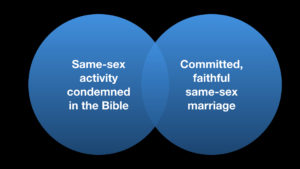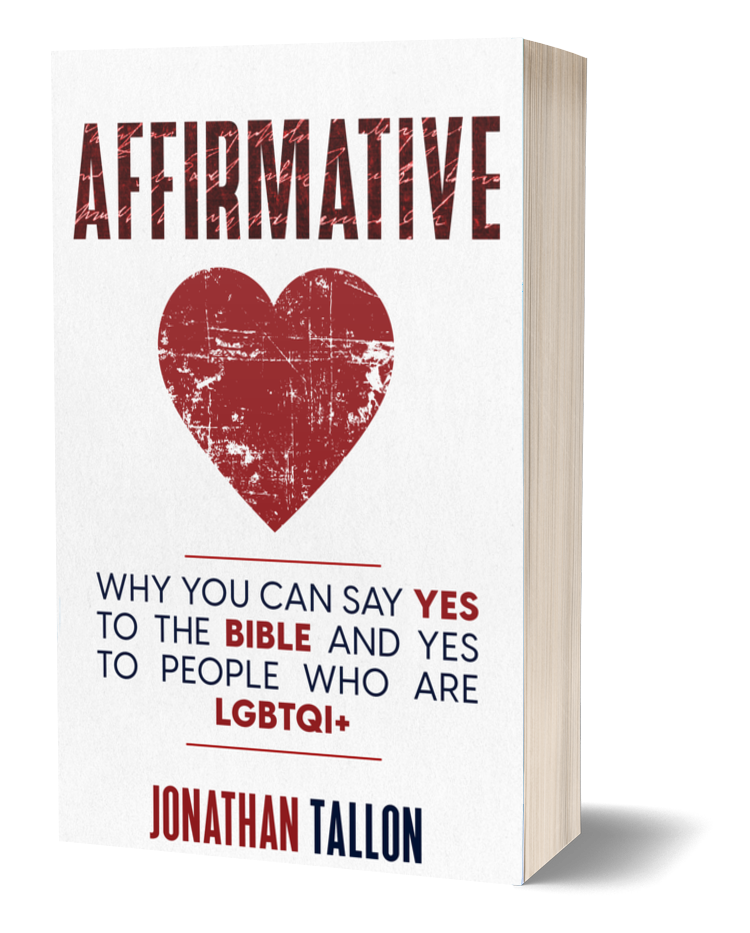Does St Paul condemn homosexuality in Romans? I don’t think so. The video explains why. Below you can find the transcript, and then scholarly resources on Roman sexuality, on what ‘against nature’ might mean, on what the females were doing, on pagan temple worship and Romans, and other interpretations not covered in the video. I have also included a short extract from Wisdom 14 as a parallel Jewish rhetorical attack on pagan idolatry.
Transcript
Does St Paul condemn all homosexuality, both those who are lesbians, those who are gays, in Romans chapter one? These are probably the most important verses in the entire Bible for this issue. But I think non-affirming interpretations are wrong. Keep watching to find out why.
Sometimes people claim a plain reading of Romans clearly condemns lesbianism and homosexuality. If you take the Word of God seriously, you need to take Paul’s condemnation seriously.
The thing is, though, the people in Paul’s churches might have thought that the plain meaning of Romans was something entirely different.
How come? The past is a foreign country – they do things differently there (LP Hartley, The Go-Between, 1953). To understand Paul’s letter to the Romans, we need to understand Paul’s world.
How the Roman world saw sexuality
The ancient world saw sexuality differently from the modern Western world. There were no categories of ‘heterosexual’ or ‘homosexual’ as specific, separate orientations. There was occasional comment or recognition about certain people who only favoured their own genders, but this was rare.
The main categories for sexuality revolved around practice – who was the dominant, active partner in an encounter, the one doing the penetrating, and who was the submissive, passive partner.
Status mattered more than gender. So, to maintain high status, a freeborn male had to be the dominant, active partner in an encounter.
In contrast a woman, who always had lower status in that society, should be the submissive, passive partner.
In general, a high status person had to be the dominant partner; a low status person or someone with no status should be the submissive partner.
So long as the freeborn man was the active partner, it was socially acceptable to have intercourse with:
- his wife, of course;
- but also with boys (freeborn in Greek culture, slaves in Roman culture);
- with slaves (male or female), because slaves had no honour;
- with prostitutes, male or female, because prostitutes had no honour;
- and with actors and bar staff, because they too had no honour in that culture.
Sleeping with someone else’s wife or daughter was not acceptable, because that was violating honour – that was moicheia: adultery.
But slaves and prostitutes had no honour to violate, so legally sleeping with a slave or a prostitute was not adultery.
And there were plenty of opportunities. So a married man might go out to a brothel, and have intercourse with a boy slave prostitute, and then return home to his wife, and that was part of the social landscape.
In general, the Roman world’s attitude to intercourse could be summarised as:
Forbidding adulteries, building brothels.
Jewish attitudes to sexuality
But Paul was Jewish. What were Jewish attitudes to intercourse? The Judaism of the time strongly linked prostitution with idolatry, and so prostitution was condemned. Similaly, pederasty was linked with idolatry, and was condemned.
But the Judaism of the time also frowned upon any type of intercourse that was non-procreative – basically, anything that couldn’t result in a pregnancy. In contrast, the Greco-Roman world generally accepted such practices as anal intercourse.

I want to emphasise what seems to us, and is, horrendous;
the use of boys for intercourse, pederasty, was widespread.
Judaism and early Christianity both condemned it. For example, an early Christian teaching manual says:
Commit no murder, adultery, corruption of children, sexual immorality…
[Didache 2:2]
[You can find more examples of early Christian teaching condemning child corruption/pederasty on my page explaining the background to 1 Corinthians 6:9-10].
Notice that adultery (moicheia), corrupting children and sexual immorality are listed separately. Of those, only adultery would be widely condemned by all three of Jewish, Christian and Greco-Roman cultures.
What about lesbian women?
But what about women with women? The ancient world, at least in official, written sources, wasn’t terribly interested. Now in part, that’s because ‘intercourse’ was not seen as really taking place because there was no penetration, and in part, it is because the male-dominated society wasn’t terribly interested generally in what women said or did. And that is true both for Greco-Roman and Jewish sources.
This is not to say that female-female sex did not take place – we know that it did from written spells and dream interpretations and other evidence that has been relatively recently compiled. But it was generally looked down on in both Greco-Roman and Jewish cultures but not much talked about.
If anything, the evidence points to it being treated as being less serious an issue within Judaism. That’s partly because it wasn’t forbidden specifically in the Torah, and partly because again there was no penetration involved. And so some rabbis would view it as being similar as an offence to masturbation. It was treated completely differently and separately from male-male intercourse.
Paul’s argument in Romans 1
OK, that’s a broad sweep of the background to sexuality in the ancient world. Let’s have a close look now at Romans 1.
Paul is conducting a sting operation here against the Jewish listener. He produces a stereotypical Jewish argument against gentile society – you can see a similar example in the book Wisdom of Solomon 13-14.
The gentiles, the pagans, worship created things rather than the creator: idolatry. And the results of idolatry are awful and evil, and God judges them. And the Jewish listener is expected to be nodding along, going ‘yes, yes’, only to be told in chapter 2 ‘you’re no better than the pagans’.
Paul begins by describing the replacement of God with images of humans, or birds, or beasts, or reptiles or animals. Some have seen echoes of Genesis here. Because of this worship of idols, God gives them up.
God gives them up to: impurity; to dishonourable passions; to a debased mind.
The key verses
So let’s now have a look at the key verses – Romans 1:26-27. This is my own translation:
On account of this [the gentile idolatry] God handed them over to dishonourable passions: for both their females exchanged the natural usage for the usage against nature, likewise also the males, having left the natural usage of females, were burnt up in their desire for each other, males in males doing that which brought shame and receiving in themselves the due rewards which inevitably came from their going astray.
There are three areas we need to look closely at – what does ‘against nature’ mean; what were the females doing, and what were the males doing?
Against nature
‘Against nature’ (para phusin) could mean a variety of things. For Paul writing elsewhere, it seems to mean going against the natural order of things. And that can be both negative, such as long hair on a man [1 Cor. 11:14]; but also positive, such as the gentiles being grafted into the ‘olive tree’ of Judaism [Rom. 11:24].
For other Jewish writers of the time, against nature could mean any form of intercourse that couldn’t lead to pregnancy. Philo is an example who uses the term ‘against nature in this way.
So, prohibited forms of intercourse would include oral and anal, it would include intercourse during menstruation, using any form of contraception, and also having intercourse where you know that one of the partners is infertile.
So if you insist on this particular understanding of ‘against nature’, be aware that it does rule out oral intercourse, it rules out using any form of contraception, and it rules out marriage between couples beyond child-bearing age, or where you know one of them is infertile.
Within the wider Greco-Roman world, ‘against nature’ could also mean excessive sexual desire: desires which go beyond proper, normal bounds. Self-control was a key virtue in the Greco-Roman world. On this understanding, Paul would be condemning the sexual activity as being an expression of excessive, uncontrolled lust.
What were the females doing?
Let’s move onto the females. Many people assume that Paul had lesbian activity in mind, but he doesn’t say that two women were involved. He says ‘the females exchanged the natural usage for the usage against nature’.
Did Paul have female-female sex in mind?
In favour of this view, it is parallel to male with male. But why talk about female-female sex first?
In the ancient world, dominated by men and where men get talked about first, this is surprising. Commentators scoot round trying to find a reason for it. Some suggest that it demonstrates Paul’s egalitarianism talking about women first, and others suggest perhaps Paul is taking a really bad example first.
But it is odd for Paul to be writing about female-female sex at all. There are very few Jewish references to it in the writings, and there aren’t that many more in the Greco-Roman world either. And also, everyone looked down on it, it wasn’t seen as a particularly gentile vice. And also, the early church didn’t understand the passage this way for roughly the first four hundred years.
But is there an alternative understanding? Yes, as we’ve heard, in Jewish sources unnatural usage often refers to intercourse which couldn’t result in a pregnancy. So females exchanging the natural usage for the usage against nature could be women changing to forms of intercourse, such as anal intercourse (perhaps used as a method of contraception), widely accepted in gentile society, but not within Judaism.
So Paul in Romans 1 could be accusing gentile, pagan women of indulging in what would be seen by Jewish contemporaries as excessive, unnatural intercourse with men.
What were the males doing?
What about the men, though? Except it doesn’t say men, it says males with males. Why is this significant? Because males includes boys, as well as men. As I’ve said, pederasty was widely accepted in the Greco-Roman world. It was by far the most common form of male same-sex activity. And it was closely associated with idolatry in Jewish thought.
But there’s an interpretation which takes not only this aspect seriously, but makes sense of the whole passage, and is also the way in which some of the earliest Christian commentators understood the passage.
Let’s remind ourselves of Paul’s argument. The critical failing of the gentiles (not all humanity) is idolatry: worshipping creation, not the creator. Pagan worship at the time of Paul included goddesses associated with fertility, like Artemis, Aphrodite, Isis, Ceres, and Cybele.

Worship of Cybele was said to include all sorts of sexual practices. Priestesses used phalluses during ecstatic worship to penetrate male eunuch priests, known as galli. These galli, dressed as women, would then also penetrate each other. Initiation involved castrating themselves as part of the ecstatic worship at festival time.
Here’s an account of that worship from the second century:
During these days they are made Galli. As the Galli sing and celebrate their orgies, frenzy falls on many of them and many who had come as mere spectators afterwards are found to have committed the great act. I will narrate what they do. Any young man who has resolved on this action, strips off his clothes, and with a loud shout bursts into the midst of the crowd, and picks up a sword from a number of swords which I suppose have been kept ready for many years for this purpose. He takes it and castrates himself and then runs wild through the city, bearing in his hands what he has cut off. He casts it into any house at will, and from this house he receives women’s raiment and ornaments. Thus they act during their ceremonies of castration. (Lucian, Syr. d. 51)
Paul was writing to Rome, where Cybele worship was part of the official calendar and where the empress Livia, Caesar Augustus’ wife, had been head of the cult.
Was the worship as frenzied as sources claimed? It is probably much exaggerated; Rome publicly valued restraint and respectability, and modified worship accordingly. Accounts of debauched orgies owe more to rhetoric than reality.
But in Romans 1 we are dealing with rhetoric. Paul has launched a rhetorical attack on pagans that focuses on the reputation of pagan worship.
How does this rhetoric fit in with the chapter? On this reading, in Romans 1:26-27 Paul is still talking about idolatry directly. Anyone in Paul’s world hearing his language would naturally link it to the ecstatic, orgiastic worship that pagans were accused of.
This explains why the females are mentioned first – they were the priestesses, the ones ruling the cult.
It explains the exchange of a natural use for an unnatural one – priestesses using phalluses. And it explains the male-male burning in desire for each other – the male galli having orgies.
It further explains the punishment (due reward) having already been received in themselves: it is a reference to self-castration.
And, just like in other Jewish literature, the frenzied pagan worship is followed up by general accusations of all sorts of wickedness. This is perfect for Paul’s broader rhetorical aim of springing a trap upon the Jewish hearer who is thinking ‘I’m better than them’ and judging the pagans.
Evaluating different interpretations of Romans 1
Let’s recap the different possibilities.
Any interpretation of Romans 1:
- has to make sense of Paul’s Jewish background;
- it has to have Paul criticising practices that are identified with pagans, not Jews;
- it should fit in with Paul’s argument about idolatry;
- and account for Paul naming females first; and ideally, it should match the earliest Christian understandings of Romans.
The idea that Paul was writing about people who are lesbians and gays fails at numerous points. No-one, Jewish or pagan, categorised sexuality this way; it doesn’t account for females being named first; and it doesn’t match early Christian understandings.
The idea that Paul was writing about female and male same-sex activity, not orientation, is stronger.
It makes sense of Paul’s Jewish background, and pederasty was associated with gentile rather than Jewish practice, although this is not particularly true of female same-sex activity. It sort of fits Paul’s argument from idolatry, if you see it as a distortion of the creation in Genesis. It doesn’t explain why females are mentioned first by Paul, and this interpretation of Romans can’t be found amongst Christian writings until the late fourth century.
What about Paul referring to females having unnatural intercourse with males, and pederasty?
This fits Paul’s Jewish background, and uses accusations that are specific to pagans. It also fits with Paul’s argument about idolatry, and makes some sense of females being named first – Paul is starting with male-female unnatural intercourse before moving to male-male pederasty. This interpretation also fits in with references to Romans in early Christian writings from the second century onwards.
But could Paul have been talking about pagan goddess worship? It fits Paul’s Jewish background, uses accusations that are closely linked to pagans (particularly in Rome), is continuing the theme of idolatry, makes sense of why females, the priestesses, are named first, and matches the earliest Christian writings on Romans.

What may have seemed a plain meaning of Paul’s letter to ancient hearers can be obscured to us because their world is different from ours.
But if Paul is condemning pederasty, or idolatrous, ecstatic orgiastic, self-harming pagan goddess worship, that’s quite different from loving, committed, faithful relationships.
Conclusion
My view? What St Paul was condemning in Romans has got nothing to do with what we’re talking about today. Remember to subscribe to the channel, and you can find links to resources and scholarship at www.bibleandhomosexuality.org.
The other key passage from Paul’s letters on this topic comes up in 1 Corinthians 6 – here is my explanation of these crucial verses.
Found this helpful? You can now get the material from this website and more in a book. Affirmative: Why You Can Say Yes to the Bible and Yes to LGBTQI+ People is available at Amazon and other major retailers. You can find out some more about the book here.
Resources on Roman sexuality
The best general background to the world of Roman sexuality (especially in relation to homosexuality) is provided by Craig Williams, which highlights some of the differences from Ancient Greece covered in Dover’s ground-breaking work. Karras also provides a helpful review of the evidence. Were there any homosexual partnerships in the modern sense that show any traces in the sources? Not many at all, but for potentially gay relationships, see Hubbard’s review of peer homosexuality. For female partnerships, see Brooten (though I disagree with her interpretation of Romans 1).
Brooten, Bernadette J. Love between Women: Early Christian Responses to Female Homoeroticism. Chicago: University of Chicago Press, 1996.
Hubbard, Thomas K. “Peer Homosexuality.” In A Companion to Greek and Roman Sexualities, edited by Thomas K. Hubbard, 128-49. Oxford: Wiley-Blackwell, 2013.
Karras, Ruth Mazo. “Active/Passive, Acts/Passions: Greek and Roman Sexualities.” The American Historical Review 105, no. 4 (2000): 1250-65.
Williams, Craig. Roman Homosexuality. 2nd ed. Oxford: Oxford University Press, 2010.
Resources on against nature and females
More scholars are now questioning strongly whether or not Romans 1:26 refers to unnatural acts with other females or with males. Some of the key work here was done by Miller, both in his 1995 article and his 1997 rebuttal of Smith (1996). See also Swancutt, Banister and Lamas Jr. Looking at interpretations of Romans, de Bruyn notes that the fourth century Ambrosiaster initially interprets Romans 1:26 as involving women having unnatural relations with men.
The meaning of ‘against nature’ as being excessive desire is forcefully argued by Dale Martin, who also critiques many traditional interpretations of Romans. Swancutt also follows this line in her interpretation.
Banister, Jamie A. “Ὁμοίως and the Use of Parallelism in Romans 1:26–27.” Journal of Biblical Literature 128, no. 3 (2009): 569-90.
de Bruyn, Theodore. “Ambrosiaster’s Interpretations of Romans 1:26-27.” Vigiliae Christianae 65, no. 5 (2011): 463-83.
Lamas Jr, Mark. “The Sin of Cunnilingus.” In Centre for the Study of Christian Origins, edited by Helen Bond, Paul Foster, Larry Hurtado, Timothy Lim, Matthew Novenson, Sara Parvis, Philippa Townsend and Margaret Williams. Edinburgh: New College, University of Edinburgh, 2017.
Martin, Dale B. “Heterosexism and the Interpretation of Romans 1:18-32.” Biblical Interpretation 3, no. 3 (1995): 332-55.
Martin, Dale B. Sex and the Single Savior: Gender and Sexuality in Biblical Interpretation. Louisville: Westminster John Knox, 2006.
Miller, James E. “The Practices of Romans 1:26: Homosexual or Heterosexual.” Novum Testamentum 37, no. 1 (1995): 1-11.
Miller, James E. “Response: Pederasty and Romans 1:27: A Response to Mark Smith.” American Academy of Religion 65, no. 4 (1997): 861-66.
Smith, Mark D. “Ancient Bisexuality and the Interpretation of Romans 1:26-27.” Journal of the American Academy of Religion 64, no. 2 (1996): 223-56.
Swancutt, Diana M. ““The Disease of Effemination”: The Charge of Effeminacy and the Verdict of God (Romans 1:18–2:16).” In New Testament Maculinities, edited by Stephen D. Moore and Janice Capel Anderson. Atlanta: Society of Biblical Literature, 2003.
Resources on pagan temple worship
The most comprehensive account is given in two articles by Jeramy Townsley, which cover the rhetoric around pagan temple worship as a background to Romans 1:26-27, and then also the early Christian interpretations of the passage, which refer to pagan worship. Budin provides an argument that sacred temple prostitution only ever existed in rhetoric and not reality. See also the blogpost by Helen King on the mundane reality of Roman worship.
Budin, Stephanie Lynn. The Myth of Sacred Prostitution in Antiquity. Cambridge: Cambridge University Press, 2008.
King, Helen. “Temple Prostitution for Christians.” In Shared Conversations. https://sharedconversations.wordpress.com/2016/08/14/temple-prostitution-for-christians/, 2016.
Townsley, Jeramy. “Paul, the Goddess Religions, and Queer Sects: Romans 1:23–28.” Journal of Biblical Literature 130, no. 4 (2011): 707-28.
Townsley, Jeramy. “Queer Sects in Patristic Commentaries on Romans 1:26-27: Goddess Cults, Free Will, and “Sex Contrary to Nature”?” Journal of the American Academy of Religion (2012).
Other interpretations
There are other interpretations of Romans 1. Overlapping with what is covered in the video, Diana Swancutt argues that Paul is condemning active, ‘masculine’ women and passive, ‘feminine’ men. In a completely different take, Elliott argues that Paul is actually targeting the scandalous behaviour of Roman emperors. I am not entirely convinced, but was surprised by how persuasive his argument is.
Elliott, Neil. Liberating Paul: The Justice of God and the Politics of the Apostle. Minneapolis: Fortress Press, 2006.
Swancutt, Diana M. ““The Disease of Effemination”: The Charge of Effeminacy and the Verdict of God (Romans 1:18–2:16).” In New Testament Maculinities, edited by Stephen D. Moore and Janice Capel Anderson. Atlanta: Society of Biblical Literature, 2003.
Excerpt from Wisdom of Solomon as an attack on pagan idolatry
Wisdom 14:21-29
21 And this became a hidden trap for humankind,
because people, in bondage to misfortune or to royal authority,
bestowed on objects of stone or wood the name that ought not to be shared.
22 Then it was not enough for them to err about the knowledge of God,
but though living in great strife due to ignorance,
they call such great evils peace.
23 For whether they kill children in their initiations, or celebrate secret mysteries,
or hold frenzied revels with strange customs,
24 they no longer keep either their lives or their marriages pure,
but they either treacherously kill one another, or grieve one another by adultery,
25 and all is a raging riot of blood and murder, theft and deceit, corruption, faithlessness, tumult, perjury,
26 confusion over what is good, forgetfulness of favours,
defiling of souls, sexual perversion,
disorder in marriages, adultery, and debauchery.
27 For the worship of idols not to be named
is the beginning and cause and end of every evil.
28 For their worshipers either rave in exultation,
or prophesy lies, or live unrighteously, or readily commit perjury;
29 for because they trust in lifeless idols
they swear wicked oaths and expect to suffer no harm.

 And so eating the wrong food makes you less holy [Lev. 20:25]. Having a tattoo makes you less holy [Lev. 19:28]. Wearing clothes from different fibres – like wool and linen together – makes you less holy [Lev. 19:19]. Even having a physical disability makes you less holy [Lev. 21:16-23].
And so eating the wrong food makes you less holy [Lev. 20:25]. Having a tattoo makes you less holy [Lev. 19:28]. Wearing clothes from different fibres – like wool and linen together – makes you less holy [Lev. 19:19]. Even having a physical disability makes you less holy [Lev. 21:16-23].
 And what about tattoos? Should everyone with a tattoo be cut off from the community? Or what about clothes with mixed fibres – I hope you don’t have any cotton-polyester blends in your wardrobe. And don’t even get me started on ham and cheese sandwiches.
And what about tattoos? Should everyone with a tattoo be cut off from the community? Or what about clothes with mixed fibres – I hope you don’t have any cotton-polyester blends in your wardrobe. And don’t even get me started on ham and cheese sandwiches.
